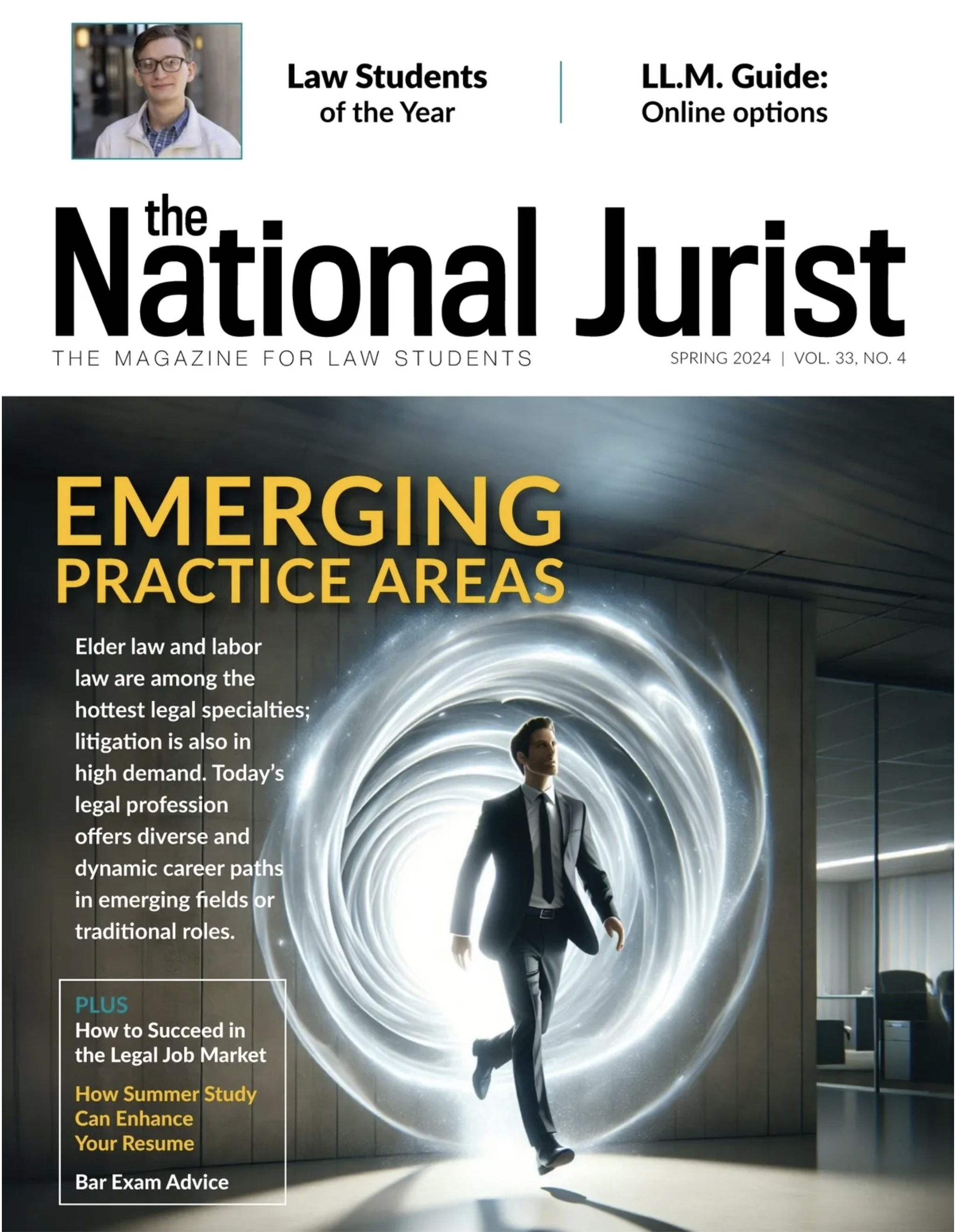More now than ever, students want to do public interest work. We explore how the field has changed over the years and who’s at the top of their game.
By Michelle Weyenberg
“We’re not grooming you to be Wall Street lawyers,” said Elena Kagan, dean of Harvard Law School, after being awarded the 2008 John R. Kramer Outstanding Law Dean Award from Equal Justice Works in August. “We’re grooming you to change the world.”
Today, more students want to work in the public interest field than in the last 15 years. By the time these students are getting to law school, many are already infected with the “public interest bug,” said David Stern, chief executive officer for Equal Justice Works.
Frankly, word has gotten back to students that lawyers are unhappy in private practice. These students want to have a rewarding, balanced life and make a difference on pressing problems.
Like others in the field today, Stern is a self-described diehard public interest type.
“I knew I was going to pursue public service with my law degree,” he said. “Even so, while in law school I felt the pressure of the private sector, especially with law firms recruiting on campus. In contrast, finding and securing a public interest job was a lot of work.”
The stereotype of someone working in public interest law16 years ago was that the person couldn’t cut it at the big firm, Stern said. Today, the competition for public interest jobs is fierce, and those who win prestigious public interest fellowships are singled out and celebrated for their achievements.
“We celebrate those who are choosing public interest work,” he said. “A change in the profession is seeing the caliber of people who want to go into this area.”
While exploring how law schools have gotten better at improving public interest law programs, we’ll examine what resources are available to students, the current trends and the top schools for public interest law.
Who’s ahead of the game?
Northeastern University School of Law took the top spot with their guaranteed clinical opportunity and public service graduation rate, among others.
Dean Emily Spieler said the core difference between her school and others is that they believe every student who enters law school should learn about law and society.
“Our approach has more to do with core values,” she said. “I think it’s extremely attractive to students interested in law school. And it’s incredibly supportive for students deciding that’s what they want to do post-graduate.”
Approximately 88.7 percent of Northeastern’s 2006 graduating class completed at least one field placement, compared to most law schools, who are in the 30 to 60 percent range.
And though Northeastern’s law school tuition is comparably higher than others, approximately 78 percent of students received scholarships and grants.
“What we’re very proud of is everyone graduates understanding what is going on,” Spieler said.
To compile the rankings of Best Law Schools for Public Interest Law, preLaw Magazine used a scoring system based on a 100-point scale to assign point values to law schools in three equally weighted categories — student involvement, curriculum and financial factors.
The categories reflected the same areas that Equal Justice Works recommends students consider when investigating law schools. The National Jurist listing was compiled independently by staff editors and did not reflect the views of Equal Justice Works.
Those in our Top 10 excel in many areas, including the strength of the clinical programs and loan assistance programs, pro bono requirements and the percentage of graduates entering the field.
The student involvement category assigned points for student activity and percentage of graduates of the Class of 2006 who entered jobs in the public interest field (defined as jobs in legal services, nonprofit organizations and public defender offices, but not including government jobs or judicial clerkships generally.)
The curriculum category assigned points for the existence of a public interest coordinator, strength of clinical programs, and existence of a voluntary or mandatory pro bono graduation requirement.
The financial factors category assigned points for cost of tuition, availability of grants and scholarships and strength of loan repayment or loan assistance programs.
Other law schools making our top 10 list include Loyola Law School in Los Angeles, Lewis and Clark College of Law, American University Washington College of Law, Stanford University, Mercer University, University of Maryland, University of Washington School of Law, University of North Carolina and the City University of New York School of Law.
CUNY Dean Michelle Anderson said overall, the vast majority of law school graduates do not go into public interest practice.
“At CUNY we have more students going into public interest law percentage-wise,” she said. “Our moto at the law school is ‘Law in the Service of Human Needs.’”
Improving public interest law
Anderson said CUNY’s curriculum focus is dedicated to public interest law — hiring professors who work in the public interest field and admitting students based on demonstrated experience in the field.
“We really are and were pioneers when we were founded in 1983,” she said. “This was a law school that was to be devoted to public interest. We have been praised for our integration of theory and practice.”
Heather Jarvis, senior program manager for Equal Justice Works, said the new trend in legal education is to incorporate skills training and allow more choices for hands-on experiences and opportunities.
“More schools are requiring pro bono service or are offering public interest certificates,” she said. “Equal Justice Works believes that students should have at least one hands-on service experience while in law school.
“You will find that incorporating public interest into the law school experience is an emphasis of law schools these days,”
Jarvis said.
For more than 20 years, Equal Justice Works has collaborated with the nation’s leading law schools, law firms, corporate legal departments and nonprofit organizations to provide the training and skills that enable attorneys to provide effective representation to vulnerable populations.
Equal Justice Works provides a continuum of programs that begin with incoming law school students and extend into later careers in the profession.
Stern said their focus was initially on the diehards, but over time they changed the focus to look more at the 100-percent solution. Which is, every student should graduate with a commitment to serving under-served communities and causes. Those values are often instilled through summer jobs, pro bono opportunities or clinical programs.
“Personal experiences where students use their skills to help a needy individual or community lead to lifelong commitments of the work,” he said. “We hope to create a profession where every lawyer gives time, talent and money to take on the justice deficit.”
Spieler said Northeastern’s first-year program has every law student working on a community-based legal research project for a real client organization. This, she says, gives students the legal skills and social context of the public interest field.
New trends in the field
In recent years, there has been a dramatic shift in law school leadership. A transfer over to a new generation of deans who care deeply about the field has already begun. These are people who really prioritize public interest programming by revamping the programs to better serve students.
“There is no substitute for leadership in this field,” Stern said.
But some students become discouraged just as they begin law school. And it could be said that first impressions really do matter.
“This woman said to me, ‘I started law school because I was interested in justice and quit after two months because no one talks about justice,’” Spieler said of a conversation she had with a woman on a flight.
Northeastern, she adds, has always attracted students that have wanted to have that conversation.
“I have always believed that the majority of people that come to law school are interested in thinking and talking about justice,” she said. “Traditionally law schools have failed to support that interest in a variety of ways. It’s one of the reasons we’re so successful.”
But the bad trends cannot be overlooked. Stern said law school rankings have a really pernicious effect on the way law schools spend their money. Those rankings do not measure what goes on inside the institution and the quality of education, he added.
“I see how these law schools are so beholden to the criteria used in the rankings,” he said. “It’s just unfortunately a cycle. In my view, applicants should go in and look for qualities that matter to them.”
Anderson said those in the field dedicate themselves to the disenfranchised people in the world who desperately need the service of lawyers.
“I think it’s a moral obligation for a lawyer to at least engage in pro bono practice,” she said. “So it’s heartening to see that schools are increasingly attending to the needs of students to try and engage in public interest practice.”
“But the need in the world is much greater than what law schools are producing today,” she added. “So we have much further to go as legal academy to try and service the real needs of the poor and disempowered in the world.”
Financial assistance improves
Spieler said the biggest challenge continues — law school is very expensive and many of the public sector and public interest job salaries have simply not kept up. Now people with this passion have to confront the fact that they have to figure out how to pay off loan debt.
“That’s really a core challenge at this point,” Spieler said. “When I went to law school you could graduate with debt and work it off, and now it’s difficult for students to do.”
But a major law school development has been the increase in Loan Repayment Assistance Programs.
Spieler said Northeastern is dedicated to strengthening its loan repayment program, which began in 1994. The law school now provides half a million dollars a year in support to students.
Many other law schools have beefed up their LRAP budgets. They vary in generosity and terms included, but it’s been an area of significant growth.
There is also that sense of isolation. Now a significant amount of law school groups raise money by conducting auctions and tithing programs.
Stern said the College Cost Reduction and Access Act of 2007 was a terrific and surprise development.
And in August, the Higher Education Reauthorization and College Opportunity Act of 2008 was signed. It establishes four new loan forgiveness and repayment programs that benefit public interest lawyers. They are:
• The John R. Justice Prosecutors and Defenders Incentive Act — providing $10,000 per year in exchange for a one time renewable three-year commitment for state and local prosecutors and public defenders.
• The Legal Assistance Loan Repayment Program — providing $6,000 per year in renewable three-year commitments to a maximum of $40,000 for civil legal assistance lawyers.
• Loan Forgiveness for Service in Areas of National Need — providing no more than $2,000 per year for five years for Public Sector Employees, including public interest legal services.
• Perkins Loan Cancellation for Public Service — providing partial loan cancellation for persons in specified public service jobs including federal public defenders.
Looking ahead
There are essential components to the success of public interest law programs, Spieler said. The first is student support in the financial sense, scholarships, loan repayment and stipends.
“Continuing to build our domestic and international relationships, starting new programs and managing curriculum and faculty recruitment are things that are constantly in review,” she said.
A major trend 15 years ago was that public interest support came mainly from career services offices. Now there are public interest advisors and independent offices and programs.
“If law school students speak loudly enough, deans will listen,” Stern said. “There is nothing like one school having [a great program], because it often inspires a peer school to have it too.”
Michelle Weyenberg is Associate Managing Editor for preLaw magazine and The National Jurist.
Best law schools for Public Interest Law
To compile the rankings of Best Law Schools for Public Interest Law, The National Jurist used a scoring system based on a 100-point scale to assign point values to law schools in three equally weighted categories — student involvement, curriculum and financial factors. The categories reflected the same areas that Equal Justice Works recommends that students consider when investigating law schools. Information gathered from The E-Guide to Public Service at America’s Law Schools: 2007-2008 Edition. The National Jurist listing was compiled independently by staff editors and did not reflect the views of Equal Justice Works.
|
1
|
Northeastern University School of Law
|
|
2
|
Loyola Law School in Los Angeles
|
|
3
|
Lewis and Clark College of Law
|
|
4
|
American University Washington College of Law
|
|
5
|
Stanford Law School
|
|
6
|
Mercer University School of Law
|
|
7
|
University of Maryland School of Law
|
|
8
|
University of Washington School of Law
|
|
9
|
University of North Carolina School of Law
|
|
10
|
City University of New York School of Law
|
|
11
|
Hofstra University School of Law
|
|
12
|
William Mitchell College of Law
|
|
13
|
University of Iowa College of Law
|
|
14
|
University of Baltimore School of Law
|
|
15
|
New York Law School
|
|
16
|
Seattle University School of Law
|
|
17
|
Temple University Law School
|
|
18
|
Albany Law School
|
|
19
|
Georgetown University Law School
|
|
20
|
Villanova University School of Law
|
|
21
|
William S. Boyd School of Law at UNLV
|
|
22
|
Gonzaga University School of Law
|
|
23
|
Loyola University-Chicago School of Law
|
|
24
|
University of Arizona College of Law
|
|
25
|
Roger Williams University School of Law
|
|
26
|
Seton Hall University School of Law
|
|
27
|
Whittier Law School
|
|
28
|
University of Colorado Law School
|
|
29
|
University of California Davis School of Law
|
|
30
|
Rutgers University-Newark School of Law
|
|
31
|
Indiana University-Bloomington School of Law
|
|
32
|
University of Oregon School of Law
|
|
33
|
Brigham Young Unversity J. Reuban Clark Law School
|
|
34
|
UCLA School of Law
|
|
35
|
University of California-Hastings College of Law
|
|
36
|
Hamline University Law School
|
|
37
|
Quinnipiac University School of Law
|
|
38
|
University of Idaho College of Law
|
|
39
|
Golden Gate University School of Law
|
|
40
|
University of Denver College of Law
|
|
41
|
West Virginia University College of Law
|
|
42
|
University of Akron School of Law
|
|
43
|
Arizona State University College of Law
|
|
44
|
University of Houston Law Center
|
|
45
|
Chicago-Kent College of Law
|
|
46
|
Drake University Law School
|
|
47
|
Syracuse University Law School
|
|
48
|
University of New Mexico School of Law
|
|
49
|
Cleveland-Marshall College of Law
|
|
50
|
Fordham University School of Law
|
|
51
|
Santa Clara University School of Law
|
|
52
|
University of Pennsylvania Law School
|
|
53
|
Southern Illinois University School of Law
|
|
54
|
Suffolk University Law School
|
|
55
|
Loyola University-New Orleans College of Law
|
|
56
|
Pepperdine University School of Law
|
|
57
|
Tulane University Law School
|
|
58
|
Emory University School of Law
|
|
59
|
Vanderbilt University Law School
|
|
60
|
University of Kansas School of Law
|
|
61
|
Oklahoma City University School of Law
|
|
62
|
Stetson University College of Law
|
|
63
|
North Carolina Central University School of Law
|
|
64
|
University of Texas-Austin School of Law
|
|
65
|
University of San Diego School of Law
|
|
66
|
University of Nebraska College of Law
|
|
67
|
Duke University School of Law
|
|
68
|
UDC David A. Clarke School of Law
|
|
69
|
Vermont Law School
|
|
70
|
University of Florida Fredric G. Levin College of Law
|
|
71
|
Harvard Law School
|
|
72
|
New England School of Law
|
|
73
|
University of Miami School of Law
|
|
74
|
Marquette University Law School
|
|
75
|
Washington and Lee University School of Law
|
Here is how we assigned points:
•The student involvement category assigned points for student activity and percentage of graduates of the Class of 2006 who entered jobs in the public interest field (defined as jobs in legal services, nonprofit organizations and public defender offices, but not including government jobs or judicial clerkships generally.)
•The curriculum category assigned points for the existence of a public interest coordinator, strength of clinical programs, and existence of a voluntary or mandatory pro bono graduation requirement.
•The financial factors category assigned points for cost of tuition, availability of grants and scholarships and strength of loan repayment or loan assistance programs.





